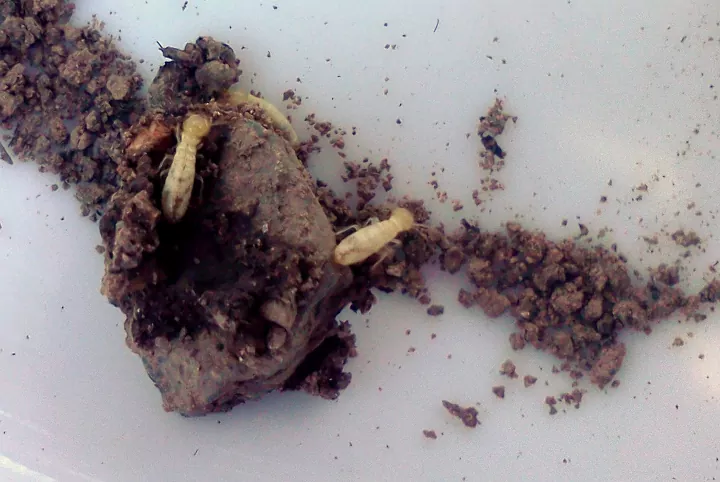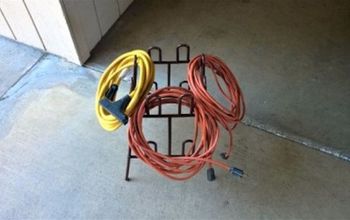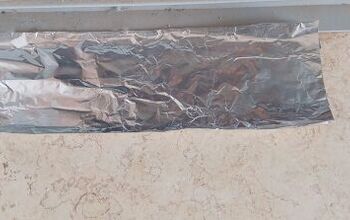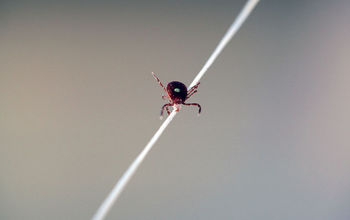How to Get Rid of Termites Naturally and Effectively

By Stacey Kelleher
Of all the issues that can cause anxiety for homeowners, termites are probably at the top of the list. After all, these determined little pests aren’t called “silent destroyers” for nothing. Every year, termites cause an estimated $5 billion in property damage, and the costs are not typically covered by homeowner’s insurance.
If you suspect termites have invaded your home, it's important to act quickly. Termites are insatiable, eating virtually around the clock. Left to their own devices, termite colonies can do significant damage in a matter of months and go on to completely destroy a home’s wood structure in just a year or two.
Fortunately, there are several effective ways to get rid of termites in the house naturally and repel future infestations without the use of toxic chemicals. This guide will walk you through it all!
Photo via Sharon Crosby
Why Do I Have Termites?
Before we dive into how to get rid of termites without chemicals, let's discuss why they're infiltrating your home in the first place.
The bottom line is: As long as there’s wood around, termites will feast. Termite infestations have nothing to do with how clean or tidy your home is. Instead, these hungry little insects are drawn to the wood structures in and around your property. Termites are detritivores, or detritus feeders, which means they eat dead trees and plants, deriving nourishment from cellulose, an organic fiber found in plants and trees.
While termites prefer to dine on wood, they will also eat plastic and paper items as well. If you take a glance around your space, you’ll probably see many different objects and materials that termites would eat, including:
- Carpet
- Fabric
- Insulation
- Plants
- Sheetrock paper
- Wood
Types of Termites
There are two common types of termites you may find around your house, and each one prefers a different type of living condition:
Drywood Termites
These critters feed on wood fencing, decks, furniture, and the structural elements of homes that remain dry. They don’t usually go near the soil.
Subterranean and Dampwood Termites
Subterranean termites, also known as dampwood termites, infest wood that has already begun to rot or has come into contact with moisture. Because they travel underground, they often go undetected by homeowners until noticeable damage has already occurred.
When Do Termites Become Active?
Termites thrive in warm, humid conditions. They are more active in the hotter months and slow down or die in dry, cold environments. You should be extra vigilant during the summer months to catch an infestation early before they cause too much destruction.
How to Tell the Difference Between Termites and Ants
Termites are similar in size and appearance to ants, which is another reason why they often go unnoticed. In fact, many people spot termite damage before they ever see a single termite in and around their home!
Flying or swarming termites are often confused with carpenter ants in particular, as both have four wings and may appear in similar spots in the home. There are some easy ways to tell the difference between them:
- Termite wings are uniform in size and shape, while the wings on flying ants are larger in the front than in the back.
- Flying ant antennae are bent or bowed, while termite antennae are nearly straight.
- Termites have broad, roundish bodies, while ants have thin waists that give them a segmented appearance.
Photo via Terri
Signs of a Termite Infestation
You may spot termites in a range of places throughout your home and property. They can be in and around your house or apartment, in the garage or shed, feeding on a fence or deck, and near trees and piles of firewood. Here are some common clues that termites have invaded your home:
Blistering on Finished Surfaces
You have noticed that inside your home, wood, wallpaper, or sheetrock may bubble, blister, or peel from termite activity within walls.
Crumbling Wood
Wood damaged by termites will crumble to the touch. If you notice that wood inside or around the perimeter of your home (in spots like decks or fences) is decaying quickly, it may be as a result of termite activity.
Discarded Wings
After swarms, termites will discard their wings in areas of high activity. The minuscule wings are thin like tissue paper, translucent, and are teardrop-shaped.
Hollow Wood
Wood that has been invaded by termites will sound hollow when tapped.
Swarms of Termites
Sometimes the first sign of termites that you'll see is the bugs themselves. Especially when they are in swarms, you might see swarming or flying termites exiting a structure.
Termite Droppings
Like most bugs and animals, termites will leave droppings behind, especially in places where they're spending a lot of time. Termite droppings are around the size of a single grain of sea salt, wood-colored, and usually located in or near the openings of termite galleries (or tunnels).
Termite Tubes and Tunnels
Made from wood and dirt mixed with termite saliva, these tubes connect underground termite colonies to their food sources above the ground. They’re usually around ¼-inch in diameter and look like a pasty dirt tunnel and can be found pretty much anywhere, from inside walls to along foundations on the exterior of the home.
Tiny Holes
Small, pinpoint holes in walls and other surfaces can be indications of termite munchies.
Risk Warning
Unlike other types of insects that are just a nuisance, termites are capable of causing significant damage to property. After a professional termite treatment, you can also use some of these DIY methods to repel and prevent the insects from returning.
Termites are small but they are mighty. Unfortunately, many homeowners find out they have termites too late, after they have compromised their home’s foundation. Even if you have never had termites in your home, it is a good idea to protect your investment and schedule a termite inspection from a reputable company at least once a year.
Photo via Audrey Karwandy
How to Repel Termites Naturally
Prevention is so important when it comes to avoiding costly termite damage. If you can deter them from ever settling in your home, you are ahead of the game. If you wait until you see swarming termites or mud tunnels, it is pretty likely that damage has already occurred.
First, there are several easy things you can do to make your home less hospitable for termites. If you don’t provide the environment they like, they will be less likely to hang around and feast on your home and property.
Keep Wood and Mulch Away From the House
Mulch is an ideal food source for termites, as it is made of cellulose and retains moisture from the air and rain. Instead of wood mulch, consider using pebbles and rocks right outside your home instead. Recycled rubber mulch also gives the look of wood mulch without the maintenance.
Along those same lines, it is also a good idea to move any wet or rotting wood away from the house. Store firewood in a dry area in the corner of your yard. Replace old fence posts and decking that are rotting and saturated with water. Also, repair any leaks that could lead to water buildup, like in gutters.
Seal Entrances and Exits
To beat termites indoors, you need to cut off any opportunities they have to enter your home. Use cement mortar to fill up cracks and crevices in exterior walls. Inside your home, use plaster to close up holes in interior walls.
Fix Any Plumbing Issues
Unlike other types of insects that don’t require a lot of moisture, termites need access to water to wet their food and break down the cellulose in wood. Do a thorough inspection of all of your plumbing systems and repair any leaks in faucets and pipes. If you notice any standing areas of water in your home, find and address the underlying cause.
How to Kill Termites Naturally with Lemon Juice and Vinegar
So, you're probably wondering: How do I get rid of termites naturally? If these critters have already set up shop, you have a few ways to get rid of them without using commercial chemical products. Because some methods work best on termites that live above the soil and others kill subterranean termites in the ground, your termite treatment plan may require some combination of the following ways to get rid of termites naturally.
This acidic spray kills termites on contact and is mainly used for subterranean termites, those insects that live and travel underground. Keep in mind that it takes several weeks to see the results of your hard work with this solution, so be patient.
Tools and Materials Needed:
- Protective gloves
- Measuring cup
- Spray bottle
- Lemons
- Lemon squeezer (optional)
- Distilled white vinegar
- Pitcher (if needed)
Step 1: Put on Your Protective Gloves
Lemon and vinegar are both highly acidic, so gloves will protect your hands from minor irritation.
Step 2: Mix the Solution
The final quantities will vary depending on how many areas you are treating. But the general formula is the juice of one lemon for every half cup of distilled white vinegar. After combining both in a spray bottle, shake the container to mix.
Step 3: Spray Infested Areas
You can spray termites directly if you see them with the vinegar solution, which will kill them on contact. You can also mix the solution in a pitcher instead and pour the solution directly into termite mud tunnels. The more you insert into the tunnels, the further it will reach and the more effective the treatment will be.
Note: Vinegar can strip away the finish on hardwood floors and furnishings, so avoid using this method on those surfaces.
How to Kill Termites Naturally with Orange Oil
Oil derived from orange peels contains a property called d-limonene, which is lethal to termites. It actually dissolves the insects’ exoskeletons, causing them to lose moisture and eventually die.
You can find orange oil online or at your local home and garden center. Orange oil is natural and biodegradable — and it smells great, too! This oil will help get rid of drywood termites naturally and subterranean termites, as well.
Tools and Materials Needed:
- Protective gloves
- Safety goggles
- Water
- Orange oil
- Garden sprayer
Step 1: Put on Your Safety Gear
Throw on your protective gloves and googles—some citrus oils can cause skin redness or irritation, so it’s better to take precautions to avoid unnecessary exposure.
Step 2: Mix the Product With Water
Most orange oil products must be mixed with water. Follow the instructions on the bottle for the proper measurements. You can prepare the solution right in the sprayer.
Step 3: Spray the Infested Areas
Spray the orange oil solution directly onto visible termites or anywhere you suspect them to be. You can also spray around the perimeter of your home, near trees, mulch, and other wood structures as a preventative measure.
Step 4: Repeat
This method usually requires multiple treatments to kill the entire colony. Spray weekly for four to six weeks until termite activity has stopped.
Orange oil works best for killing drywood termites and is not especially effective for subterranean colonies. Try combining this with another method to treat termites above and under the ground.
How to Kill Termites with Borax
Sodium borate, commonly called Borax, is another way to treat termites without risk of exposure to harsh chemicals. Borax is poisonous to termites—as its dust sticks to termite bodies, they ingest it during the grooming process and it kills them within three days to a week.
Keep in mind that while Borax is not as harsh as other chemical pesticides, it can cause stomach irritation in pets. It can also cause unpleasant side effects in humans if ingested in high quantities. So, if you have kids or pets at home, be sure to take precautions to keep them away from the areas you’re treating for termites if you use this method.
Tools and Materials Needed:
- Protective gloves
- Safety goggles or glasses
- Borax
- Hot water
- Large heat-safe bucket or bowl
- Garden sprayer
Step 1: Put on Protective Gloves and Goggles
Borax exposure can irritate the skin or eyes, so safety equipment like protective gloves and goggles is advised.
Step 2: Heat the Water
Again, the quantity of this termite killer needed will depend on the area being treated, but you will need eight ounces of water for every teaspoon of Borax.
Step 3: Add the Borax
Add Borax powder and the hot water to a heat-safe bowl or bucket, giving it time to dissolve completely.
Step 4: Transfer the Solution to a Sprayer
Carefully pour the solution into a heat-safe sprayer.
Step 5: Treat the Areas of Infestation
Spray-treat any areas with signs of termite activity including infested soil and wood surfaces. You can also treat mud tunnels near your home.
Step 6: Wait
As noted above, Borax treatment takes several days to work. The best results will occur around 10-20 days after application. You can repeat the process monthly to prevent reinfestation.
This DIY Borax termite treatment is cost-effective and easy to make. There is also a wide range of pre-mixed commercial Borax termite treatments available that include gels, foams, soaps, and baits designed for different areas of your home and yard.
How To Kill Termites Naturally with Nematodes
This method is probably the most fascinating of the group. It involves the use of the termite’s natural predator: the dreaded nematode. Nematodes are small parasitic worms that feed on termites. Nematodes are completely harmless to humans and pets, but they can help control an impressive 200+ different insects and pests.
Tools and Materials Needed:
- Protective gloves
- Water
- Nematodes
- Watering can or grass sprayer
All commercially-sold nematodes have their own instructions for use. Generally, nematodes are diluted in water in different quantities depending on the size of the area being treated. Like the other methods, you will spray the solution on and in areas infested with termites. Because nematodes are live creatures, be sure to keep them refrigerated between use.
Photo via Michael Patton
When to Call an Exterminator
The methods we’ve outlined above can be very effective for mild termite infestations. However, if after several treatments you are still seeing termite swarms or increased signs of termite damage, you should take the next step and call a professional exterminator.
Have you found a tried and true method for killing termites without chemicals? Share your tips below!






























Frequently asked questions
Have a question about this project?